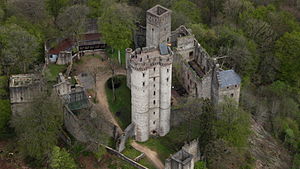Kasselburg
| Kasselburg | |
|---|---|
|
Kasselburg, western view, aerial photo (2015) |
|
| Alternative name (s): | Castilburg, Castelberch |
| Creation time : | 1100 to 1200 |
| Castle type : | Hilltop castle |
| Conservation status: | Preserved essential parts |
| Standing position : | Nobles, counts, dukes |
| Place: | Pelm |
| Geographical location | 50 ° 14 '21 " N , 6 ° 41' 7" E |
| Height: | 490 m above sea level NHN |
The Kasselburg is the ruin of a hilltop castle on a 490 meter high basalt stock in Pelm near Gerolstein in the Rhineland-Palatinate district of Vulkaneifel .
description
The landmark of Kasselburg, which is still preserved today, is its 37 meter high gate and residential tower , designed as a double tower , the origins of which are not exactly clear. It was previously assumed that the Lords of Blankenheim built it shortly after 1335, but architectural research has shown that the tower was built in several phases and therefore cannot be attributed to just one client . Presumably, with the expansion of the castle in 1452, the gate lost its protective function. The spacious outer bailey with its Burgmannen houses and farm buildings dates from that time .
In the double tower, which visitors is open and offers a good view of the surroundings, it is not, despite its size to the dungeon . The latter, built around 1200, is smaller and stands in the eastern part of the inner castle . It has a square floor plan and was extended into a residential tower in the 14th century.
Also a part of the main castle is almost 33 meters long Palas , which also dates from the 14th century.
history
The castle was built in the 12th century. Your builders may have been the Lords of Castel, but this is not entirely certain. The castle was first mentioned in 1291 as Castilburg, and in 1314 it was called Castelberch .
According to the current state of research, it is not clear who was the owner of the facility before 1335. What is certain, however, is that Gerhard V. von Blankenheim became its owner in the course of an inheritance that year and thus founded the Blankenheim-Kasselburg line. In the meantime raised to the rank of imperial count , this line of the Blankenheimers died out with Count Gerhard VII in 1406, and the complex came to Wilhelm I von Loen zu Heinsberg through marriage .
Other owners followed, for example the Counts of the Mark , the Dukes of Arenberg and the Electors of Trier . Many interest groups have claimed the Kasselburg for themselves in the course of history, so that in 1674 the Reich Chamber of Commerce in Wetzlar was called upon to put an end to the property disputes. When the judges awarded the castle to the Dukes of Arenberg, the building soon served as barracks for the Duke of Arenberg Artillery . This started the decline of the complex: In the 18th century it was temporarily the seat of an Arenberg forest ranger, but as early as 1744 it was referred to as modo, decayed.
After France confiscated the castle in 1794, it came into Prussian possession in 1815 . An unexpected impetus to save the ruins came in 1838 from King Friedrich Wilhelm IV. After a visit, he suggested repair work, and after the completion of the Cologne – Trier railway line, the railway company donated 1000 thalers to the development of the double tower, which was already famous at the time, to give its passengers “something to offer".
At the beginning of the 20th century, the state preservation authorities carried out further restorations . The state palace administration of Rhineland-Palatinate, which became the owner of the Kasselburg in 1946, had maintenance measures carried out. In the meantime, the facility is under the care of the Castles, Palaces and Antiquities Directorate of the General Directorate for Cultural Heritage Rhineland-Palatinate , which has been the successor organization to the State Castle and Palatinate Administration since 1998.
Eagle and Wolf Park Kasselburg
The castle is surrounded and penetrated by the eagle and wolf park of the Vulkaneifel district, which is also responsible for the direct care of the castle complex. "Penetrated" because it contains the cages for the various birds of prey in the park , which were fitted into the ruins of the inner castle. The Kasselburg, like the eagle and wolf park with the exception of the predator enclosure , is open to visitors and there is daily feeding of the timber wolves and, on some days, a bird of prey flight show .
literature
- Alfred Dahn: The Kasselburg. History and current use . In: Eifelverein (Ed.): Yearbook of the Daun district in 1976 . Weiss, 1977, ISSN 0720-6976 , p. 19th ff . ( online - narratives, stories and current data).
- Matthias Kordel: KasselburgSammelwerk = The most beautiful palaces and castles in the Eifel . Wartberg, Gudensberg-Gleichen 1999, ISBN 3-86134-482-3 , p. 32-33 .
- Michael Losse : Kasselburg . In: Joachim Zeune (ed.): Hohe Eifel and Ahrtal . Konrad Theiss Verlag GmbH, Stuttgart 2003, ISBN 3-8062-1775-0 , p. 74-77 .
Web links
- Entry on Kasselburg in the scientific database " EBIDAT " of the European Castle Institute
- The Kasselburg near "Castles, Palaces, Antiquities Rhineland-Palatinate"
- Entry on Kasselburg in the private database "Alle Burgen".
- Reconstruction drawing by Wolfgang Braun


